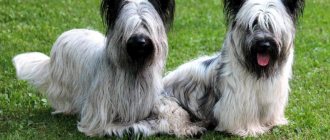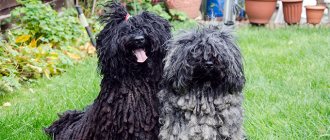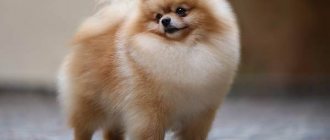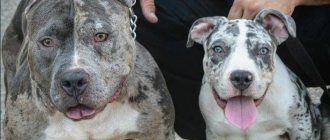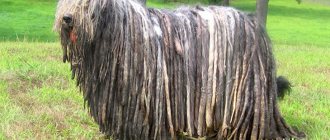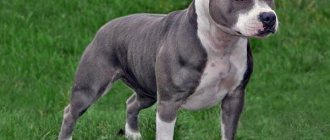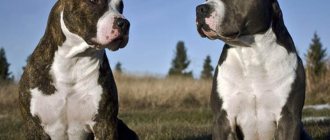Hunting dogs for hunting burrowing animals were specially bred by crossing different small hunting breeds. Indeed, a strong, brave, fearless dog of small size is capable of entering a hole and driving an animal out of it, or pulling out its carcass. Such dogs must have certain qualities, such as agility, speed of reaction, strength, anger.
At the moment, there are two main groups of burrowing hunting dogs: dachshunds and terriers. The second group is much more numerous, however, dachshunds are much older, that is, they were bred earlier than terriers
Dachshunds
The dachshund was bred in the middle of the 16th century in Germany; at least the first mentions of a hunting dog with an elongated body and short legs date back to this time. This breed of hunting dogs was bred specifically for hunting animals in holes, such as rabbits, foxes, badgers, raccoons, etc. The dachshund is ideally suited for this: a muscular, elongated body, powerful paws, a narrow muzzle with strong jaws.
Varieties of dachshunds
There are three different breeds of dachshunds: short-haired, long-haired and wire-haired. The difference is in the length and color of the coat, otherwise all three breeds are similar. The height at the withers of a dachshund is about 17-25 cm, for girls and boys respectively. Weight 7-10 kg. All dachshunds have a well-developed chest, strong and sturdy front legs, and an agile, muscular, characteristically elongated body. The breed standard allows any color: black, black, red-brown, fawn, gray with red spots.
Dachshund character
All dachshunds have a playful and easy-going character. They are highly trainable. They can be excellent companions on long walks. They have excellent hunting qualities, which are not difficult to develop, since the instinct of a hunter in dachshunds is laid down at the genetic level, that is, even a small puppy knows that he needs to hunt and teaching him this is not a problem. They get along very poorly with pets, so it is not recommended to keep them with other pets. They do not like familiar treatment, but at the same time they are very devoted to their owner. In some situations, they do not hesitate to defend the owner and his household.
Training
You should start teaching dachshunds different commands from a very early age, from two to three months in the form of a game. Dachshunds are very intelligent by nature, so training will not be problematic. The main thing is not to hit the puppy: Firstly, it will make the dog angry and it will be afraid; Secondly, when the pet grows up, it will try to stand up for itself, which is fraught with conflicts in which the dog will get its way and very soon it will understand what needs to be done to achieve its goal. During training, if the command is carried out correctly, be sure to encourage the pet and talk to it affectionately. If the puppy does not obey, does not follow commands, then switch his attention to something else, for example, if the puppy does not obey the command “come to me,” then you can pretend that you are running away from him: the puppy will definitely come running.
Advantages and disadvantages of the dachshund
The undoubted advantages include an unsurpassed hunting instinct, an intelligent, flexible character, agility and strength, which can become an excellent friend and companion on hikes.
Among the disadvantages, it can be noted that dachshunds do not get along well with other pets; for up to four months, a small dachshund should be carried in your arms while going up and down the stairs: otherwise, a disease of the musculoskeletal system may develop due to the peculiarities of the body structure.
Brief conclusion about the tax
The dachshund is small in size, strong and agile, with proper training it can become an excellent hunting assistant, can be easily kept in an apartment, and is easy to train. Among the disadvantages, it can be noted that all dachshunds do not get along well with other pets.
Classification of burrow rocks
Breeds that were bred to improve hunting skills are called burrowing breeds. These species are adapted to work in animal shelters. The exterior of the species was carefully thought out and developed in compliance with all “hunting” requirements. The intelligence of the breeds does not fail either. Dogs cope with complex tasks with ease and are easy to train.
Burrowing dogs
Table 1. Categories of burrowing dogs.
| Category | Characteristic | Popular breeds |
| Workers | Dogs that have retained the instinctive skills of hunters. Having undergone special training - baiting - they become skilled catchers of small animals. | Dachshund, Jagdterrier, Cairn terrier |
| Part-time workers | Breeds, selective work on which was not based on the development of hunting skills. Theoretically, such a dog will cope with catching, but its exterior is not adapted for visiting holes. | Kerry Blue, Manchester Terrier |
| Non-working | Breeds belonging to the hunting group of terriers, but not capable of hunting. Such animals are bred as pets, which was the main reason for the loss of “agility”. | Yorkshire and Japanese Terrier, Russian Toy |
Fox terrier
The homeland of the fox terrier is England. The first descriptions of a small hunting dog for hunting animals in holes date back to the 16th century. The Fox Terrier breed was developed from small hunting dogs that Roman soldiers brought with them when they conquered the British Isles. The Roman troops left the islands, but the small fox hunting dog remained. Currently, the Fox Terrier is the property of England.
At the moment, there are two standards for the Fox Terrier breed: – Wire Fox Terrier; - Smooth Fox Terrier. Despite the name, the difference is not only in the type of coat, they are completely different dogs, with different habits and characters.
The Fox Terrier is the most common breed not only in England, but throughout the world. The Fox Terrier has for a long time proven itself to be the best fox hunter, despite its small size, it has enormous power and courage.
The meaning of a dachshund barking during a hunt
The dachshund’s voice is clear, reaches far and signals the owner about what is happening:
- barking and whining - discovered prey;
- change in timbre - the beginning of the duel;
- the voice sounds lower, becomes hoarse - the dachshund’s aggression is growing, he is ready to “take” the animal;
- a dull roar - prey in the teeth.
Even from underground the taxi driver’s voice can be clearly heard. A working dog barks only if there is an animal in the hole; an empty dog is considered a vice.
Description of the Fox Terrier breed
Height at the withers ranges from 30 to 40 cm for girls and boys, respectively. Weight is about 6-8 kg. The Fox Terrier has a proportional body, strong straight legs, a strong head on a muscular neck. The Wire Fox Terrier has a hair-like coat that requires plucking a couple of times a year. The Smooth Fox Terrier has extremely short hair and sheds twice a year, so it must be brushed with a thick brush. Any color is allowed, but not monochromatic.
Fox Terrier Character
Like all hunting dogs, the Fox Terrier has a friendly character towards the owner and all his household members, is wary and distrustful of strangers, loves children and can play with them for hours. Doesn't get along well with pets and has a strong hunting instinct. Fox Terriers are loyal, easy to train, very intelligent, and can make independent decisions, especially when hunting.
Training
It is necessary to start training from an early age, from two to three months. Commands should be taught gradually alternating with the game.
Repeating commands for too long tires the puppy and he may not follow them.
During training, you should definitely reward for correctly executed commands: for example, give a treat or stroke, say kind words. Of course, it is better to immediately teach the puppy to eat at a certain time and exclusively at home. The puppy must firmly understand and unquestioningly follow all basic commands.
It is better to start training and developing hunting skills from seven to eight months of age under the supervision of a specialist, because baiting an animal is a responsible activity and requires maximum attention to avoid problematic situations.
Advantages and disadvantages of the Fox Terrier
Due to its small size, the Fox Terrier is excellent for keeping in an apartment, loves children, has an easy-going character, is distrustful of strangers, an excellent and strong hunter, and an excellent companion on hikes. The Fox Terrier is very hardy; in order for him to get tired, he needs to expend enormous effort, which is almost impossible. Disadvantages include aggression towards other pets; an overdeveloped hunting instinct can play a cruel joke: a pet can chase a cat or other animal in the city, completely ignoring commands.
Brief summary about the Fox Terrier
In general, this is an excellent hunting dog for burrow hunting, unpretentious, devoted to its owner, loving children, taking up little space in even a small apartment.
Dog baiting and training
Baiting is the improvement of the innate hunting skills of a burrowing breed through training.
Some breeds are endowed with such a hypertrophied hunting instinct that they simply do not need training. For such a dog, one or two trips to the hole are enough to understand the essence of the work and begin “independent activities.” But there are very few such individuals, so for most dogs, preliminary baiting is used.
Baiting a young dog
Depending on the breed of the dog and its “profile”, different types of baiting are used. All of them can be divided into three types:
- ground baiting;
- using artificial burrows;
- in a natural environment.
Training on the ground
The basis of such baiting is the development of the dog’s aggressive attitude towards the prey it encounters. Such a “meeting” is organized in a pre-prepared area, fenced and safe.
At the first stage of training, the decoy animal is placed in a cage and the dog is kicked out. She learns to bark and react correctly to prey. Over time, the task becomes more difficult by releasing the game and giving the dog the opportunity to fight.
The goal is to make the prey flee
Rats, rabbits and foxes are used as decoy animals. Dog handlers strongly do not recommend working with cats. Using this example, a dog will only learn to chase and prey. In addition, the cat serves as a weak potential object, and training with its participation will bring problems in the future in a peaceful environment.
You can make the task more difficult for a partially trained dog in the dark by training the skill of catching in the dark (in burrows). As soon as a young dog begins to easily overcome a rat, he is transferred to work with foxes.
Use of artificial burrows
Training using an artificial hole begins when the puppy reaches 4-5 months of age. First, the dog is trained to behave in the hole without using bait. When the puppy freely breaks into the shelter, he is trained to work with inanimate objects.
Badger caught
First of all, a young hunter must learn to pull objects out of a hole on command. They are later replaced with stuffed prey. When the dog learns to work with the animal simulator, a pre-caught animal is included in the work. The first meetings with live prey should be introductory - the fox is kept on a leash so that the dog can bark at it.
The test for a hunting dog will be catching a fox in an artificial hole. In this case, a jaw releaser will come in handy, since the dog will definitely use a death grip.
Video - first training of puppies
Training in natural conditions
The first hunt of a young dog takes place in a special territory. Areas with inhabited burrows of foxes or raccoon dogs are selected. An encounter with a raccoon can end tragically for a dog.
Badger is too strong a rival for a young dog
It is not recommended to use areas with empty holes, as the dog will learn to bark at “empty” places. The easiest way to find suitable burrows is in winter - by following tracks in the snow, which will help identify the resident. They track a residential hole in absolute silence, without approaching the shelter.
Jagdterrier
The German Jagdterrier was bred specifically for hunting, and not only for burrowing. The Jagdterrier is essentially a versatile and vicious hunter who can work both in burrows and as a hound or gun dog. This breed was developed at the beginning of the 20th century in Germany. The final breed standard was approved in the post-war period.
Description of the Jagdterrier breed
The Jagdterrier does not look very attractive in appearance, but he doesn’t need that: sheer functionality and practicality. Height at the withers is 34-40 cm, weight is from 7 to 11 kg. A prerequisite for the breed standard: the chest girth must be 10-11 cm greater than the height at the withers. This is due to endurance: if the girth is less, the dog will not be able to run or perform physical activity, as well as voice its location. If the girth is greater, the dog will not be able to work normally in the hole. The Jagdterrier is allowed two types of coat: smooth-haired and wire-haired. The color is mostly dark tones, black, black and tan, gray and black, saddleback, etc. The coat itself is very dense, with the same length all over the body on the belly and on the inside of the hind thighs. Therefore, the dog is not afraid of dirt, water, cold, or various parasites. This breed of hunting burrowing dogs has strong and strong paws, a flexible, muscular body, a powerful neck and a wedge-shaped head with powerful jaws.
The Jagdterrier has a “death grip”, that is, it is capable of strangling its opponent
Hunting with a dachshund on the scent
The dog's capabilities are not limited to burrow hunting. She can pursue prey in the forest, in water, and in the field. The tendency to follow the scent can be detected while walking with your dachshund. If he shows interest in fresh animal tracks, then there is a high probability that he will work on the surface. Such dogs confidently find a wounded animal, chasing it along a bloody trail. It is quite possible to hunt a hare with dachshunds, tracking down a larger animal. The deer is in no hurry to run away from the taxi, not seeing it as a big threat. And for the hunter, this behavior becomes convenient for the chase.
Character of the Jagdterrier breed
The German Jagdterrier has an easy-going character, but with obvious aggression towards animals (pets also fall into this category), and therefore it is not recommended to keep the Jagdterrier together with other pets. As a companion dog, the Jagdterrier is not suitable; its prerogative is exclusively to hunt any game or animal. In extreme cases, it can be used as a watchman, but in this case the dog’s psyche is often disturbed. In terms of hunting qualities, the Jagdterrier has no equal: it is capable of being a burrow dog, a hound, and a gun dog on the water. This is a versatile hunter. It is aggressive towards the beast, vicious, attacks without fear, and therefore often dies. In this connection, when training, it is necessary to achieve exceptional execution of commands in order to protect the pet from troubles.
Training
It is necessary to start training a Jagdterrier at two months. Exercise in such a way that by the age of five months the puppy knows the basic commands and carries them out unquestioningly. From the age of six months, you can begin to teach the puppy to hunt, take it out into the forest, and let it run through the forest under the supervision of the owner. Graduation should be started gradually and under the supervision of a specialist. By the age of two, the dog is fully prepared for hunting.
Advantages and disadvantages
The Jagdterrier is an unpretentious dog, capable of getting used to even the most difficult conditions, provided that it is treated with affection. Suitable for keeping in an apartment. Among the disadvantages, it should be noted that the Jagd Terrier requires long walks with great physical activity. Practically does not get along with pets and needs firm training.
Principles of training burrowing dogs
When getting a burrowing dog as a companion, the owner must be prepared in advance that raising the pet will take a long time and patiently. Norniks are independent and self-sufficient, authority must be gained from them, and controllability must be achieved . An ill-mannered dog can run away and get into trouble or attack someone it considers game.
But much more serious efforts will be needed to train working dogs. For a hunting breed, it is not enough to be guided by instinct; you need to be able to implement it correctly. An obligatory part of the comprehensive training of burrowers is the so-called training - baiting a young dog with a real animal, which it will have to hunt in the future.
The training of a burrowing dog should be carried out by experienced specialists.
An important discipline for a novice hunter is also mastering artificial holes. Competitions of burrowing dogs also take place at the same facilities, which are as close to reality as possible.
Professional training begins no earlier than the dog is six months old, depending on its breed and individual abilities. First, the dog learns to find and bark the animal correctly, then it trains on a skin, for example, a fox, to pull prey out of a hole. All successful actions must be encouraged by the owner.
